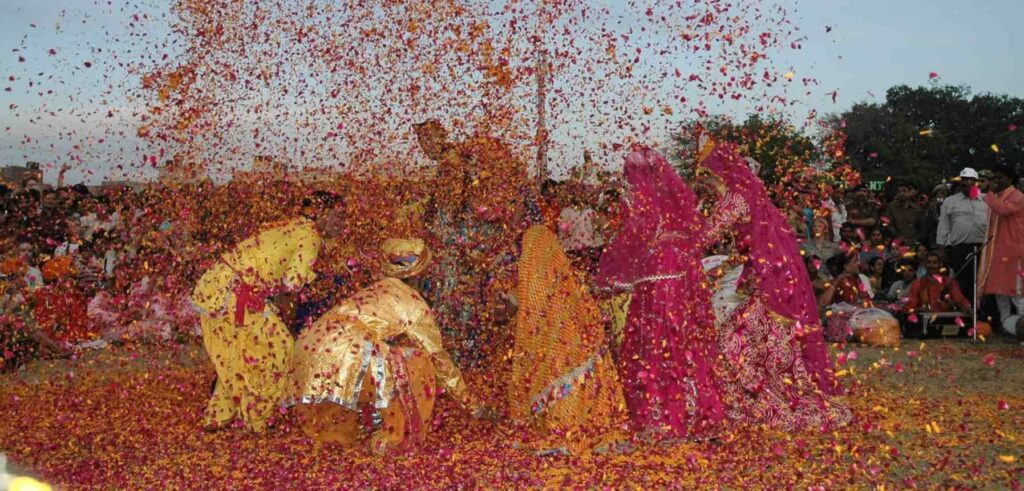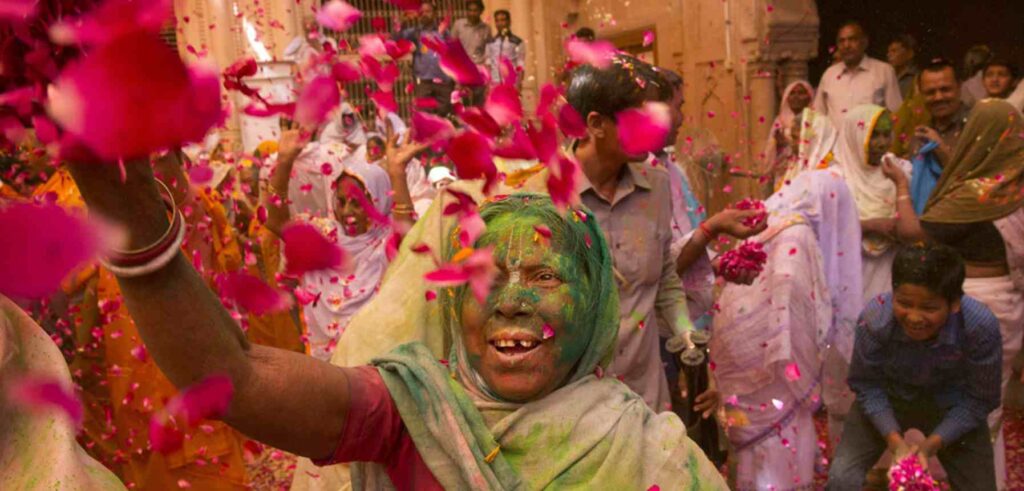Holi Festival In Mathura: Braj Ki Holi 2025

Holi, the festival of colours, is one of the significant festivals celebrated in India. Well known for its beautiful traditions, Holi is one of India’s most vivid celebrations, celebrated with full energy, zeal, excitement, and enthusiasm everywhere throughout the nation. While Holi is celebrated in almost every part of India, the Holi festival in Mathura, Vrindavan, and nearby areas attracts tourists and pilgrims worldwide because of its unique customs and traditions. It is an exciting mix of fun, cultural storytelling, and vibrant hues, making it one of the most unique festivals in India.
Why celebrate Holi at Mathura and Vrindavan?
Although Holi is celebrated in practically every region of India, it is particularly well-known in Braj. The historical region of Braj includes Mathura, Vrindavan and a few neighbouring areas. Due to its distinctive traditions and customs, the Holi celebration in Mathura and Vrindavan draws pilgrims and tourists from every part of the country.
Mathura is the birthplace of Lord Krishna, and Vrindavan is where he grew up. Krishna complained to his mother as a child that his friend Radha was fair-skinned, whereas he had a dark complexion. Yashoda, his mother, suggested that he playfully paint Radha with colours. In the past, Krishna from Nandgaon would visit Radha village Barsana to colour her and other Gopis. They also used to playfully beat him with sticks. Hence, the tradition evolved.
Braj ki Holi 2025 Schedule

| Date | Event Description | Location |
| 3 February | Basant Panchami: Holi flag hoisting | Basant Panchami: Holi flag hoisting |
| 28 February | Maha Shivaratri: First Holi procession | Ladliji Temple, Barsana |
| 7 March | Phag Aamantran: Laddu Holi in the evening | Ladliji Mahal, Barsana |
| 8 March | Lathmar Holi | Barsana |
| 9 March | Lathmar Holi | Nandgaon |
| 10 March | Rangbhari Holi and Phoolon ki Holi | Vrindavan and Banke Bihari Temple |
| 11 March | Holi celebrations | Dwarkadheesh Temple and Gokul |
| 12 March | Holi at Banke Bihari Temple and Dol Celebrations | Vrindavan |
| 13 March | Holika Dahan | Phalen and across Braj |
| 14 March | Dhulhadi: Rangon ki Holi | Entire Braj region |
| 15 March | Huranga | Baldev’s Dauji Temple |
| 16 March | Huranga | Nandgaon |
| 17 March | Traditional Huranga | Jao village |
| 18 March | Charakula Dance | Mukharai |
| 19 March | Huranga | Batain |
| 20 March | Huranga | Gidoh |
| 21 March | Rang Panchami: Huranga | Khaira |
| 22 March | Holi celebrations | Ranganathji Temple, Vrindavan |
Special Holi Celebrations in Braj ki Holi

Experience the vibrant Braj ki Holi, where colors, music, and tradition come alive! Celebrate in Barsana with Lathmar Holi, witness Nandgaon’s playful festivities, and immerse yourself in Vrindavan’s Phoolon ki Holi. A magical celebration of love and colors awaits!
Lathmar Holi

Lathmar Holi is the most famous celebration in the Braj ki holi, particularly in Barsana and Nandgaon. The term ‘Lathmar’ translates to ‘stick-beating,’ this playful festival involves women playfully beating men with sticks (lathis) while men defend themselves with shields. The festival is rooted in a legend where Lord Krishna playfully smeared colour on Radha’s face, leading to her friends chasing him away with sticks. The celebration recreates this playful banter between the Gopis (female devotees) and Gops (male devotees) through song, dance, and colour.
Laddu Mar Holi

Laddu Mar Holi marks the beginning of the Holi festivities in Braj ki holi. During this event, priests at the Radha Rani Temple throw laddus (sweet round balls) from rooftops, which devotees catch and throw at each other. Throwing laddus symbolizes the playful teasing of Lord Krishna by the Gopis, creating an atmosphere filled with joy and devotion.
Phool Wali Holi (Flower Holi)

Phool Wali Holi is celebrated primarily at the Banke Bihari Temple in Vrindavan. Instead of traditional colours, this version uses flower petals to celebrate. The temple is adorned with flowers, and devotees show each other petals while singing devotional songs. This celebration emphasizes purity and devotion to Lord Krishna.
Chhadi Maar Holi

Chhadi Maar Holi takes place in Gokul and involves a similar playful spirit as Lathmar Holi but focuses on stick play without the same level of organized rivalry. Participants engage in playful stick fights while singing traditional songs dedicated to Lord Krishna. This event fosters community spirit and joy among participants.
Widow’s Holi

A more recent addition to Braj’s Holi celebrations is Widow’s Holi (Vidhva Holi), which aims to include widows in the festivities traditionally shunned from celebrations. This celebration promotes inclusivity and allows widows to partake in the joyous atmosphere by playing with colours and participating in community events.
When Is the Holi festival in Mathura?

Like most other Hindu festivals, Holi is celebrated on the full moon day of spring in the month of Phalgun, i.e., February-March. The next Holi festival in Mathura will be celebrated on 14 March 2025.
Celebrate the Holi Festival in Mathura with TripzyGo
Experiencing the Holi festival in Mathura offers more than colour; it’s an immersion into local culture. Visitors can partake in traditional dances, savour local delicacies like thandai (a drink often infused with bhang), and enjoy soulful bhajans that resonate through the streets. The atmosphere is exciting as people from all walks of life celebrate love and friendship. Holi celebration in Mathura is an unforgettable experience that combines spirituality, tradition, and sheer joy. Travelling to Mathura for Holi with TripzyGo will be an experience of a lifetime for anyone eager to immerse themselves in one of India’s most vibrant festivals.

